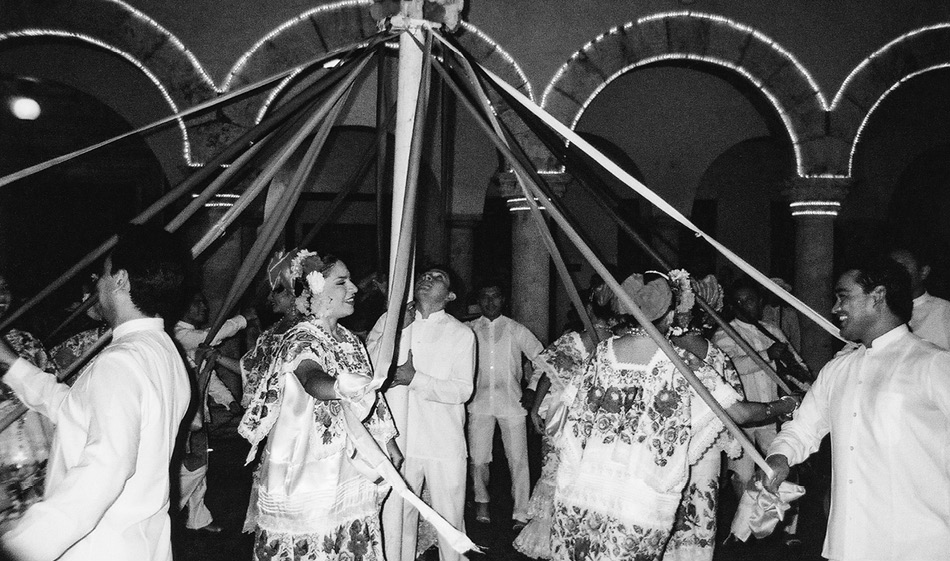Mexico Celebration

El Baile de las Cintas, Chichén Itzá, Yucatán, Mexico.
The shades, the smells, the sounds, the sights, the celebration! I had just arrived in Mexico and been thrust into my first fiesta: the Guelaguetza, an annual event with its roots in a commemoration of the Aztec maize deity, Centeotl, praying for a strong harvest in the season to come. Today the Guelaguetza is a blend of indigenous and Christian traditions, and brings together people and religions from across the central state of Oaxaca in a festival of parades, dance, song, and food.
The festival, which is celebrated on the final two Mondays of July, completely dominates this city of over 300,000 people. It seems like every house is decorated, every street is taking part, and every family has its own particular style of celebratory dress. With little previous experience of Mexico, I congratulated myself on having hit lucky, inadvertently having timed my visit to experience this amazing event.
Except what I soon came to realize is the Guelaguetza, extraordinary as it is, is not the exception in Mexico but the rule. This is a country where, in almost any place, at almost any time, you can pretty much guarantee that someone is having a party. Forget people begging off social occasions or saying they feel too tired to go out after a long week at work. For Mexicans there are no excuses. The fiesta comes first, always. This is not just because Mexicans love having a good time, though they do, and they’re better at it than almost anyone else. It’s also about a deep-rooted culture of recognition and remembrance. It’s about celebrating people both living and dead, commemorating traditions both indigenous and imported, and recognizing Mexico’s rich cultural and ethnic diversity.
One of the most famous Mexican festivals, Día de Muertos (Day of the Dead) is all about commemorating ancestors. Families gather to remember those who have died and to build ofrenda (altars with offerings) in the home to welcome back the spirits of the dead into the world of the living, stocked with provisions and gifts such as a favorite meal or the favorite toy of a child who has died. In smaller towns and villages where ancestors may be buried nearby, marigolds are sometimes laid as a path to help spirits find their way home.
If the Día de Muertos is one of the most visible national holidays, there are also countless more local fiestas, especially those commemorating the saint who has been adopted by every village, town, and city district. These fiestas patronales happen annually and can be either a single day of celebrations or a full-blown novenario, where events happen across a nine-day period. Saints range from the more well known to the less pious, such as San Malverde, unofficial patron saint of drug dealers.
Whether national or local, Aztec or Christian in origin, or borrowed modern conventions such as baby showers and gender reveal parties, celebrations play a central role in Mexican life. It is not just events with religious roots, either: sporting events too, from soccer to baseball, boxing and the Olympics, are an excuse to throw massive parties. And of course there are widespread celebrations each year to mark the Grito de Dolores, independence from the Spanish.
A Mexican fiesta is not just about the event itself, but the preparations that take place in the weeks and days prior. Often these will involve the preparation of foods traditional for that particular event: chiles en nogada, chile poblano stuffed with a meat hash and topped with a walnut sauce, pomegranate seeds, and parsley (so representing the colors of the Mexican flag); pan de muerto, a sweet, anise-flavored bread roll to be eaten on Día de Muertos; or rosca de reyes (ring of kings), a circular, cheese-and-nut-decorated bread made specially for Epiphany. Flowers, decorations, and dresses are also agonized over and made to order for the specific fiesta. The whole family will get involved in these preparations: I remember sitting in the kitchen of the family I was staying with, making empanadas while watching the youngest child de-seed a pomegranate for chile en nogada. Whenever an event is happening, everyone will chip in: bringing food, arranging entertainment, and basically doing whatever they can to make life easy for the host.
The Mexican culture of celebration doesn’t just make it an intoxicating place to visit. It is also a value that most of us could learn a great deal from. It is so easy to underestimate the importance of celebration, never taking the time to stop and think about why it’s important to mark things, whether it is a new achievement or a remembrance of people no longer with us. The emphasis that Mexican culture puts on this is partly about taking more joy in life, but it’s also about remembering what is really important. So many of us prioritize things that we won’t see as important when we look back on our lives, like the next work deadline. Mexicans will never let that get in the way of an important fiesta, and there is a recognition that these things should take priority. What Mexico teaches us is that celebration is not a frivolous or unimportant thing, to be done only on special occasions, but a fundamental part of a life well lived. Given it ranks second on the global Happy Planet Index, it’s safe to say that we could all take a leaf out of Mexico’s book, and learn to party on.